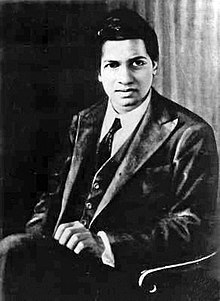Srinivasa Aiyangar Ramanujan
|
Srinivasa Ramanujan FRS |
|
|---|---|
 |
|
| Born |
22 December 1887 Erode, Madras Presidency, British India (present-day Tamil Nadu, India) |
| Died | 26 April 1920 (aged 32) Kumbakonam, Madras Presidency, British India (present-day Tamil Nadu, India) |
| Residence |
|
| Nationality | Indian |
| Education |
|
| Known for | |
| Awards | Fellow of the Royal Society |
| Scientific career | |
| Fields | Mathematics |
| Institutions | Trinity College, Cambridge |
| Thesis | Highly Composite Numbers (1916) |
| Academic advisors | |
| Influences | G. S. Carr |
| Influenced | G. H. Hardy |
| Signature | |
Srinivasa Ramanujan FRS (/ˈʃriːniˌvɑːsə rɑːˈmɑːnʊdʒən/;![]() listen ; 22 December 1887 – 26 April 1920) was an Indian mathematician who lived during the British Rule in India. Though he had almost no formal training in pure mathematics, he made substantial contributions to mathematical analysis, number theory, infinite series, and continued fractions, including solutions to mathematical problems considered to be unsolvable. Ramanujan initially developed his own mathematical research in isolation; it was quickly recognized by Indian mathematicians. Seeking mathematicians who could better understand his work, in 1913 he began a postal partnership with the English mathematician G. H. Hardy at the University of Cambridge, England. Recognizing the extraordinary work sent to him as samples, Hardy arranged travel for Ramanujan to Cambridge. In his notes, Ramanujan had produced groundbreaking new theorems, including some that Hardy stated had "defeated [him and his colleagues] completely", in addition to rediscovering recently proven but highly advanced results.
listen ; 22 December 1887 – 26 April 1920) was an Indian mathematician who lived during the British Rule in India. Though he had almost no formal training in pure mathematics, he made substantial contributions to mathematical analysis, number theory, infinite series, and continued fractions, including solutions to mathematical problems considered to be unsolvable. Ramanujan initially developed his own mathematical research in isolation; it was quickly recognized by Indian mathematicians. Seeking mathematicians who could better understand his work, in 1913 he began a postal partnership with the English mathematician G. H. Hardy at the University of Cambridge, England. Recognizing the extraordinary work sent to him as samples, Hardy arranged travel for Ramanujan to Cambridge. In his notes, Ramanujan had produced groundbreaking new theorems, including some that Hardy stated had "defeated [him and his colleagues] completely", in addition to rediscovering recently proven but highly advanced results.
...
Wikipedia
